How’s your posture doing these days? Are you sitting hunched over in your desk job for hours on end? I’ll bet you’re worried about your sedentary lifestyle.
You’re not alone.
Less than 1 in 10 office workers exercise regularly despite working long hours. Yet, our ability to focus diminishes when we sit in the same position for too long.
There are many pros and cons of using standing desks – and some downright bizarre myths are doing the rounds. I’ll be busting some of these in this article.
Stand back, relax, and enjoy the ride.
(Related: UpDown Desk Review: Still The Best?)
Wait, Sitting Down Causes Cancer?

Above: A standing desk in its lowest height setting works like a traditional office desk.
If you’ve heard the phrase “sitting is the new smoking,” you might be panicked, but this kind of rhetoric doing the rounds is neither helpful nor true.
Decades of research reveal a clear link between smoking and the following physical health implications:
- Cancers.
- Heart disease.
- Strokes.
- Lung diseases.
- Diabetes.
- Chronic obstructive pulmonary disease.
- Dental problems.
- Loss of hearing and vision.
In Australia alone, the healthcare burden attributed to smoking is $6.8 billion each year due to the 1.7 million hospital admissions to treat smoking-related conditions.
There are inherent risks of prolonged sitting, but nowhere near the magnitude of smoking. Some of these are:
- Muscle weakness and imbalance.
- Poor posture.
- Increased risk of obesity.
- Cardiovascular issues like DVT.
- Diabetes.
Important!
While anecdotal evidence suggests that “extended sitting raises your risk for colorectal, ovarian, and endometrial cancers,” there is very little peer-reviewed or quantifiable research on the matter to verify this.
Until we have more evidence and reach a scientific consensus, we can all relax.
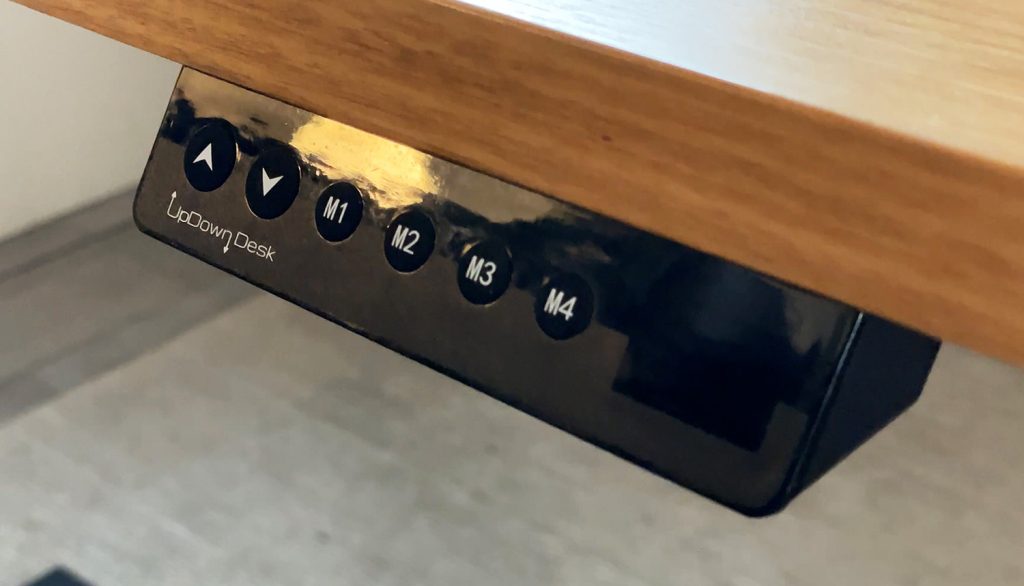
Above: Most standing desks have electronic height controllers with programmable height presets.
To Sit or Not to Sit? That Is the Question.
That’s not to say you can’t obtain health improvements by using a standing desk. You can – and I’ll discuss some of those shortly.
But it’s a stretch to market standing desks as cancer-prevention devices.
(Related: Officeworks Newhaven Standing Desk: Worth $500?)
If you’ve been standing on your feet all day, every day, hoping to fend off the C-word, there’s a good chance you’re doing more harm than good.
In fact, standing all day is likely to exacerbate back pain and neck pain.
Did You Know?
“People who stand for work have more back pain and slightly higher rates of cardiovascular disease,” says Jack Dennerlein, professor of physical therapy at Northeastern University in Boston.
At this stage, the jury is still out on the cause and the effect.
Contrary to Professor Denerlein’s assertion, it could be that those who suffer from back pain are more likely to stand when working to cope with their preexisting back pain.
And if you’re standing all day to burn calories, the impact will likely underwhelm you. As I’m about to show you, the number of extra calories you burn while standing is minimal.
(Related: Steelcase Migration SE Pro Standing Desk Review).
Pros Of Using A Sit-Stand Desk.
Here are the main benefits you can expect when using a standing desk.

Above: The most common desktop size is 150 cm X 75 cm, enough to accommodate two monitors or laptops.
1. Better Posture.
Standing desks encourage better posture compared to sitting desks by reducing the tendency to slouch or hunch over a desk.
When using one, you engage your core muscles and distribute your weight more evenly between your feet, which naturally promotes a straighter spine.
As well as better posture, using a standing desk:
- Burns more calories throughout the day compared to using a sitting desk (read on to learn exactly how much).
- Promotes blood flow and may reduce the risk of blood clots.
2. Improved Productivity.
After sitting for a while, inertia sets in. We become lethargic, fatigued, and start to fidget. Brain fog clouds our judgment.
When standing regularly, your body engages more muscles to maintain balance.
This increases your heart rate and gets blood and oxygen circulating through your body, fueling your focus and energy levels.
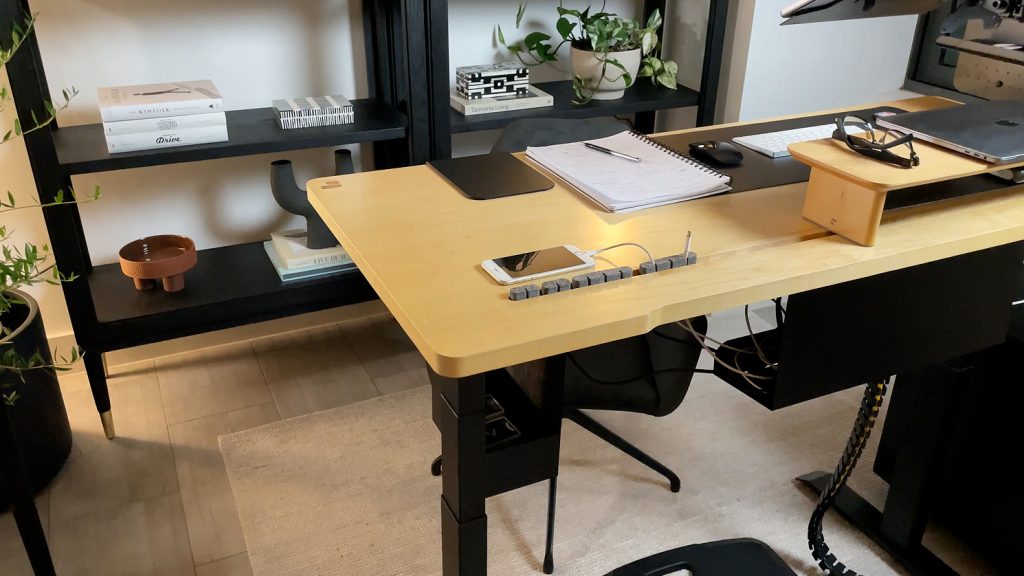
Above: Some standing desks have advanced cable management systems. A cable spine and cable tray manage power cables under this EverDesk Max. Meanwhile, a cable channel and a scallop keep data cables under control.
3. Fosters Collaboration.
Standing promotes alertness and active engagement since office workers are unable to get too comfortable.
As far as practicality is concerned, standing makes it much easier to approach others and share visual aids such as infographics on your laptop.
Downsides Of Using A Sit-Stand Desk.
In the interest of being impartial, it’s also important to understand the downsides of using a sit-stand desk.
1. Can Cause Lower Back Pain.
When standing, your pelvis is often pushed backward, increasing the curve of your lower back (lumbar region).
This puts additional pressure on the soft tissues surrounding the lumbar region of your spine.
Technique matters.
Standing alone won’t fix your posture. There’s a correct way to do it – with your elbows and 90-degree angles, back straight, feet flat to the floor, and computer screen positioned at eye level.
If your technique deviates from that, take a break to prevent further injury. You’ll be ready for longer stints when you’ve mastered the technique.
2. Fidgeting And Distractions.
A standing desk is a novel piece of office apparatus to fiddle with.
As such, setting it to the right height can be a distraction, especially if you have OCD tendencies and need your desk height to be millimetre perfect.
Also, when you have a greater view of the entire office, you see other colleagues.

Above: Pair your standing desk with a normal office chair to alternate between sitting and standing at regular intervals.
3. An Expensive Toy.
Standing desks aren’t cheap. While cheap standing desks exist, most will put a $500-$1,500 dent in your pocket.
If budget is not a priority, we’ve reviewed the best standing desks in Australia to help you whittle down your shortlist.
Expert Tip.
Prices start as little as $450 for the Artiss standing desk and are as high as $2,500 for the UpDown Pro, a fully featured model with optional extras.
4. Cable Management.
When elevating your desk, you reveal an unsightly tangle of electrical cables that connect to all your tech. Tidiness may be one of the most important factors when deciding if a standing desk is worth it.
Here’s how you can keep your cables neat. Some of the tips included in the supplementary article reveal exactly how to:
- Disconnect and detangle everything.
- Plan your layout to avoid unnecessary tangles.
- Plug your tech into an extension to accommodate any height changes.
- Use velcro cable ties to keep cables together.
- Label cables to trace and manage cables when fault-finding or unplugging.
- Find a compatible cable tray to keep your wires tucked away.
- Get a cable box to hide your extensions and plugs.
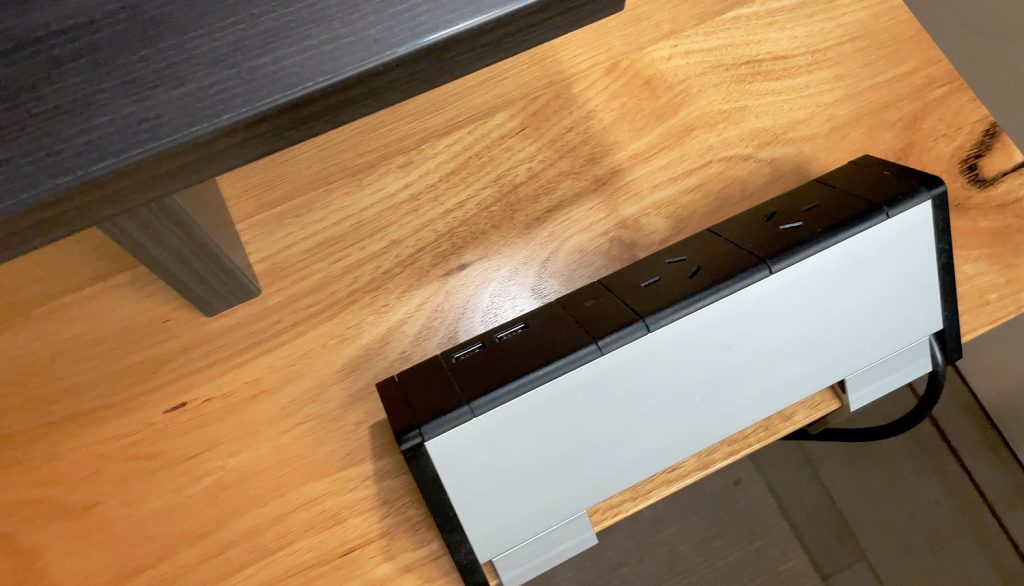
Above: I recommend that you run a power supply to the top of your standing desk, eliminating the need to crawl under your desk each time you need to plug something in.
5. Lack Of Storage.
Many sit-stand desks, particularly electric height-adjustable standing desks, have limited or no drawer space.
Even the priciest desks, like the Desky Dual and UpDown Pro (both around $1,000-$2,000, depending on your choice of desktop) have no built-in storage.
Your tech, accessories, and stationery have to go somewhere.
You’ll need to factor in the cost of an additional purchase of drawers that match your desk and the decor of the room.
- A good quality set of drawers that matches your desk will cost between $50-$250.
- Decent floating shelves will cost you $25-$50 and are super easy to install.
Important!
Hardwoods and softwoods are always much more expensive than particle board or engineered wood alternatives.
If you do get under-desk storage, make sure you get an electric desk with anti-collision technology. This will prevent your desk from attempting to crush anything in its descent.
6. The Spotlight Effect.
Psychologist Dr Derek Chapman suggests that the use of a standing desk contributes to a phenomenon known as the “spotlight effect.”
Expert Tip.
This occurs when we’re standing, and we believe that our surrounding colleagues are paying undue attention to us – particularly if we are the only ones standing.
This can be distracting for the user, but can also put introverts off from standing and using the desk for its intended purposes.
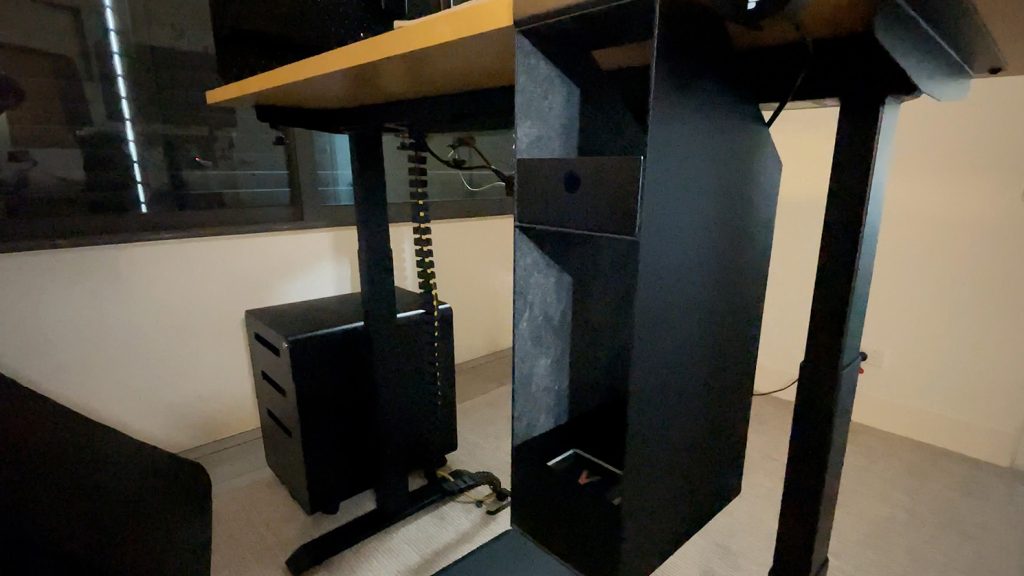
Above: Keep your desktop clean with under-desk drawers and a 3-drawer filing cabinet.
7 Different Types Of Standing Desks.
Standing desks come in a few different types, and knowing your main options is helpful before jumping in and making a rash purchase.
Choosing the right one depends on your available space, work requirements, and health considerations.
1. Fixed standing desks.
- Are set at a fixed height and cannot be adjusted.
- Benefits: Retail or customer service employees who are required to stand for prolonged periods.
- Disadvantages: No flexibility to adjust height, so these are rarely a great ergonomic fit.
- Price: Reasonable.
2. Adjustable height desks.
- Allow users to switch between the sitting and standing position by changing the desk’s height.
- Benefits: Multitaskers like artists and designers who frequently switch between tasks.
- Disadvantages: These tend to be the most expensive desks.
- Price: Premium.
3. Desktop converters.
- Placed on top of an existing desk or workspace to convert a normal desk into a sit-stand workstation.
- Benefits: A remote office worker or freelancer who wants to convert their existing sitting desk.
- Disadvantages: Limited workspace for multiple monitors and accessories.
- Price: Budget-friendly.
4. Corner standing desks (L-shaped).
- Fit into corners to create an extra workspace).
- Benefits: Those who use multiple monitors, such as traders, graphic designers, or financial analysts.
- Disadvantages: These are often bulky and require more space, and working in a corner can be uninspiring.
- Price: Expensive.
5. Wall-mounted standing desks.
- Are attached to a wall and can be folded up, saving floor space.
- Benefits: Those who use multiple monitors, such as traders, graphic designers, or financial analysts.
- Disadvantages: A permanent installation means you have much less flexibility if you want to switch things up and reshuffle your furniture.
- Price: Economical.
6. Mobile standing desks.
- Are equipped with wheels or casters, allowing users to easily move the desk around their workspace.
- Benefits: Employees who frequently collaborate with colleagues in different parts of the office.
- Disadvantages: Less stable compared to stationary options.
- Price: Moderate.
7. Exercise standing desks.
- Have a built-in treadmill or exercise bike that allows users to walk or pedal while performing tasks.
- Benefits: Health-conscious office workers who are time-poor and unable to attend a gym outside of standard work hours.
- Disadvantages: These are quite distracting; the novelty also seems to wear off with many workers ditching them after a few months.
- Price: Overpriced.
Sit-Stand Desks And The Case For Weight Loss.
It’s quite logical to assume that you’d burn more calories when standing as opposed to sitting.
And while it’s true that you do, lower estimates suggest that you can only expect to burn an additional 24 calories when standing for three hours.
To burn calories while working at your desk, you need to get your heart pumping faster. I find treadmill desks to be invasive.
Walking at the same time as typing just isn’t practical. But the smoother motions of pedalling when using a desk bike make it a much more appropriate choice.
Remember to track your performance on a Fitbit or iWatch.
Top Tips For How To Use A Standing Desk.
Once you’ve decided on the right type of standing desk, there are a few things that you need to be aware of when getting down to business.
- Calibrate your workstation. Elbows should be at a 90-degree angle, and your screen should be at eye level.
- Invest in an ergonomic chair. Get your hands on the ultimate ergonomic pairing for your suite; we reviewed the top 12 chairs that are all the rage in Australia.
- Check out floating shelves. A space-saver that helps you maintain a clutter-free desk.
- Check the floor level. An uneven floor can affect the stability of your desk; floor mats or adjustable legs can rectify this.
- Consider a balance board. This promotes core strength and improves circulation by encouraging subtle weight shifts. You can burn up to 100 calories per hour when standing on one.
- Buy an anti-fatigue mat. One of these will provide cushioning and support for your feet when standing for long periods.
Frequently Asked Questions About Standing Desks.
Let me debunk a few myths that surround standing desks.
How Much Time Should You Stand At A Standing Desk?
There are those who swear by perfect ratios, but everybody is different. Our anatomies are different.
You may have more stamina than someone else. If you’re carrying a few more pounds, gravity is going to drain your energy much quicker and put more pressure on your feet.
Important!
Research from the University of Waterloo suggests that you should stand for 45 minutes and sit for 15 minutes per hour.
Personally, I think that’s extreme.
Contrastingly, in another controlled study, the Canada Research Chair in Spine Biomechanics and Injury Prevention found that 50% of participants developed low back pain when standing at an ergonomic desk for two consecutive hours.
Your body will give you cues when it’s time to sit or stand. If you want a periodic prompt, set a timer on your phone or Amazon Alexa, but don’t subject yourself to unnecessary torture.
Will A Stand-up Desk Help Alleviate Back Pain?
Standing improves your posture and promotes the natural s-curve of your spine, which allows for an even distribution of weight and takes the pressure off your lower back.
By standing upright, you’re less prone to stretching out your neck, reducing tension in your shoulders.
Can A Standing Desk Help You Lose Weight?
When standing at your desk, your body works a little harder and burns more calories, but it’s not an effective way to lose weight.
It’s better to conserve your energy and take a brisk walk during your lunch break for 30 minutes. Doing so would burn 100–200 calories.
Are Standing Desks Are Worth It?
You need variation in your day to stay active and improve your posture. A standing desk offers that but is not a get-out-of-jail-free card for regular exercise.
Many people acquire a standing desk because they’re desperate to get more active, and yet have a poor work-life balance.
I get it.
Working, looking after pets and kids, cooking, cleaning, practising self-care, remembering to drink eight glasses of water a day and eat five pieces of fruit and veg – finding time to keep active seems nigh on impossible.
But you have to – otherwise, you’ll burn out.
Exercising before or after work helps you decompress. Exercising during work compounds your stress. (That rhymes!)
A sit-stand desk will bring some balance to your working day, but it’s only one part of a bigger health equation.
Tommy

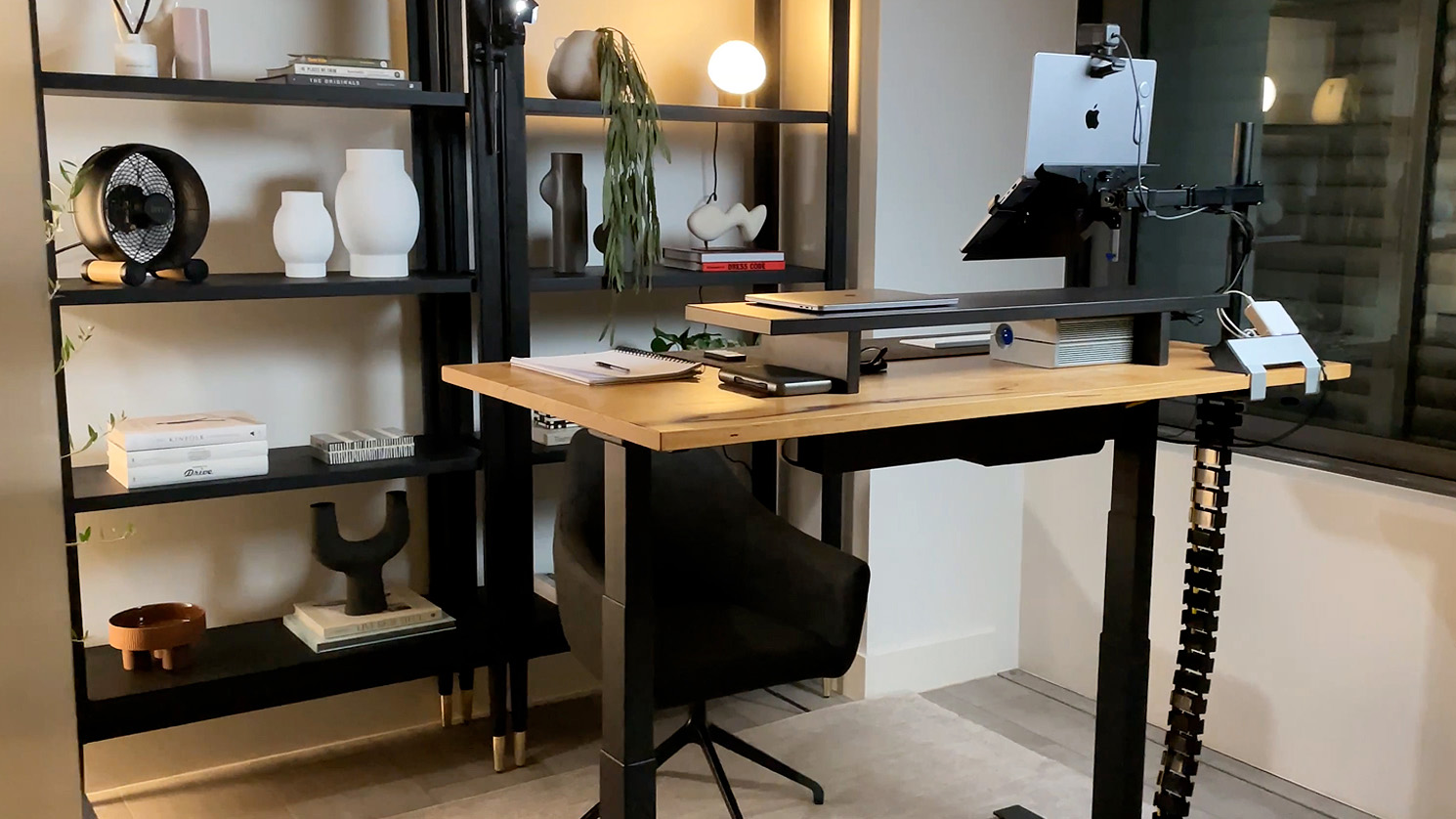
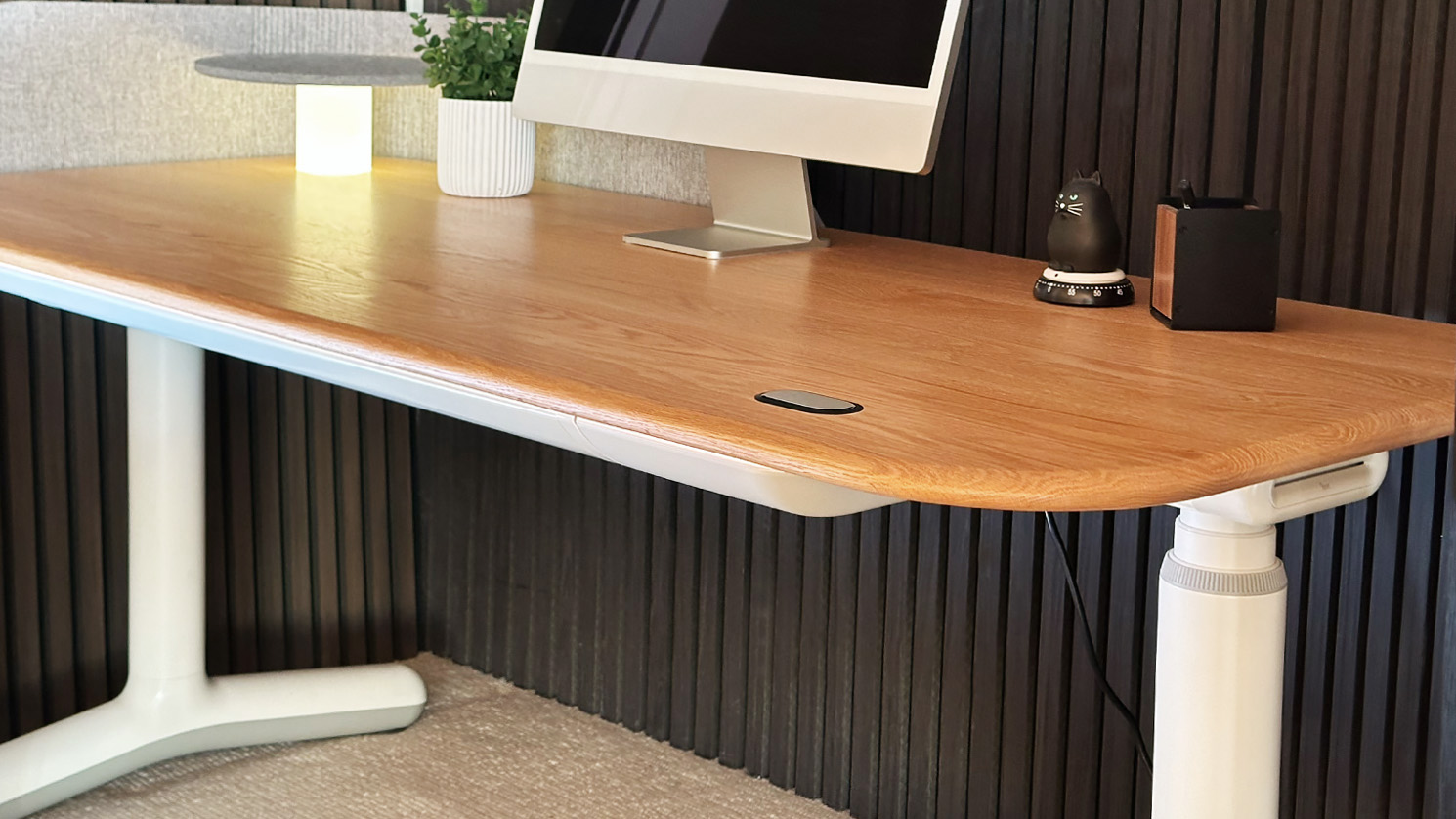




Sam says:
Hi.
I am considering buying an electric standing desk. I have a large 44 inch monitor and am concerned about monitor wobble. Which desk and setup do you recommend?
Sam
Steven McConnell says:
44″ is huge – and side-to-side wobble is your biggest enemy. But most premium standing desks in Australia have minimal wobble. Search for “best standing desks in Australia – Arielle” in Google to find my comprehensive review of all standing desks – it will help you make the right decision.